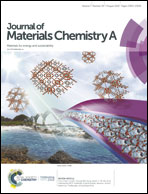High stability of ultra-small and isolated gold nanoparticles in metal–organic framework materials†
Abstract
Gold nanoparticles (NPs) exhibit optical, catalytic, and physical properties that are scientifically fascinating and essential for many applications. However, the challenge is to synthesize and disperse ultra-small and highly stable NPs. We demonstrate here that isolated and ultra-small (∼1 nm) Au NPs can be synthesized by photo-reduction of HAuCl4 inside thiol-functionalized MOFs, including MIL-101 (Cr) and a novel class of MOFs, MOF-808–SH. A combination of physical, imaging, and spectroscopic measurements and ab initio calculations confirms that the Au NPs are dispersed inside the bulk of the MOFs and demonstrate that the thiol group is critical to stabilize the Au NPs deeply inside individual pores which overcomes the major issue of external nucleation on the outer surfaces. The thiol-functionalized MOFs thus fulfill a dual purpose: they foster the nucleation of the Au NPs and also provide confinement and a framework that keeps the NPs separate. Moreover, the stability of NPs is tested by a series of wet chemical processes (transmetalation) and photocatalytic water reduction. Spectroscopic and TEM studies of the system after these chemical tests show that the Au NPs are remarkably stable (<1.5% diameter change/hour), even under harsh aqueous and irradiation environments, necessary for catalytic applications.



 Please wait while we load your content...
Please wait while we load your content...
